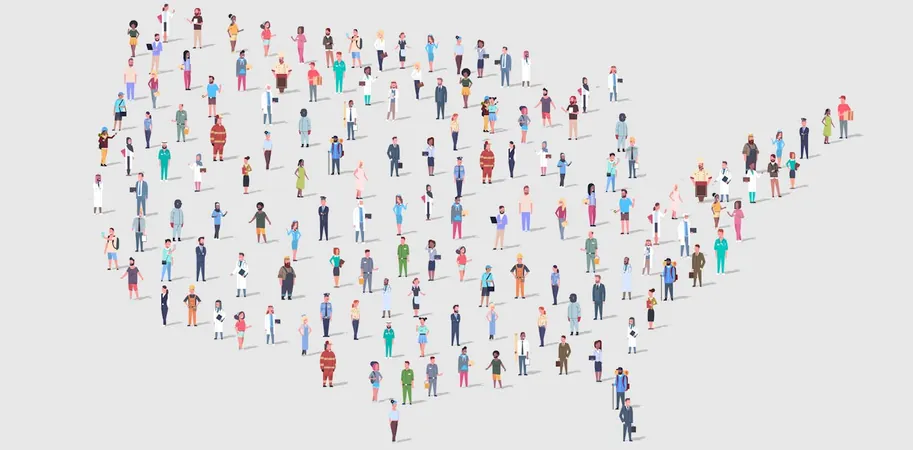
Alarming Study Reveals 208 Million Americans Are Overweight or Obese – Will This Crisis Get Worse?
2024-11-27
Author: Yu
A Shocking Reality in America
A groundbreaking new study highlights a grim reality in America: nearly half of adolescents and three-quarters of adults were classified as clinically overweight or obese in 2021. The findings, released in the illustrious journal The Lancet, show that obesity rates have skyrocketed – more than doubling since 1990.
If current trends continue without urgent intervention, predictions indicate that by 2050, over 80% of adults and nearly 60% of adolescents could be classified as overweight or obese. This research, conducted by the Global Burden of Disease Study 2021 U.S. Obesity Forecasting Collaborator Group, includes insights from more than 300 experts specializing in obesity.
Why Should You Care?
The United States already grapples with one of the highest obesity rates in the world, and the implications are dire. In 2021 alone, obesity contributed to approximately 335,000 deaths, severely hindering health improvements and life expectancy compared to other high-income nations. Obesity raises the risk of numerous chronic illnesses, including diabetes, heart disease, stroke, cancer, and mental health disorders.
From an economic perspective, a report by Republican members of the Joint Economic Committee of the U.S. Congress anticipates that obesity-related healthcare costs could soar to an astonishing $9.1 trillion over the next decade. This could have lasting effects on both the economy and healthcare systems across the country.
The Child Crisis: A Ticking Time Bomb
Particularly alarming is the rapid increase in obesity rates among children and adolescents. Data shows that since 1990, obesity rates have more than doubled among adolescents aged 15 to 24. Shockingly, nearly 20% of U.S. children and adolescents, ages 2 to 19, are living with obesity. By 2050, projections suggest that 1 in 5 children and 1 in 3 adolescents will experience obesity, leading to the early onset of chronic diseases and potential mental health issues.
Geographical Gaps and Socioeconomic Disparities
Research reveals significant geographical variations in obesity rates across the United States, with southern states displaying the highest prevalence. Studies further indicate that obesity disproportionately affects Black and Hispanic populations compared to their white counterparts, exacerbated by systemic issues like discrimination, unequal access to education and healthcare, and economic disparities.
Innovative Solutions and Ongoing Research
Recent research is exploring effective interventions to counter obesity. For instance, a study in Seattle found that taxation on sweetened beverages led to a decrease in average body mass index among children. Additionally, community-based initiatives are focused on increasing access to healthy foods and physical activity, particularly in underserved areas.
The search for new anti-obesity medications is ongoing, with clinical studies monitoring both safety and effectiveness. Moreover, innovative tech-driven solutions, like mobile health apps for weight management, are gaining traction. However, questions remain about the scalability and sustainability of these programs, posing a challenge for wider adoption across populations.
Looking Ahead: What’s Next?
The study casts a concerning shadow over the future of obesity trends in America through 2050, provided no significant measures are enacted. Although new-generation anti-obesity medications could potentially transform obesity management, their success will hinge on cost, accessibility, and individual variability in response.
As we stand on the brink of an obesity crisis, urgent action is essential to flip the script on this epidemic. The clock is ticking—will we take action now, or will our health and economy continue to pay the price?



 Brasil (PT)
Brasil (PT)
 Canada (EN)
Canada (EN)
 Chile (ES)
Chile (ES)
 España (ES)
España (ES)
 France (FR)
France (FR)
 Hong Kong (EN)
Hong Kong (EN)
 Italia (IT)
Italia (IT)
 日本 (JA)
日本 (JA)
 Magyarország (HU)
Magyarország (HU)
 Norge (NO)
Norge (NO)
 Polska (PL)
Polska (PL)
 Schweiz (DE)
Schweiz (DE)
 Singapore (EN)
Singapore (EN)
 Sverige (SV)
Sverige (SV)
 Suomi (FI)
Suomi (FI)
 Türkiye (TR)
Türkiye (TR)